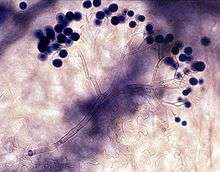Hyaloperonospora parasitica
| Hyaloperonospora parasitica | |
|---|---|
 | |
| Hyaloperonospora arabidopsidis on Arabidopsis thaliana | |
| Scientific classification | |
| Domain: | Eukaryota |
| (unranked): | SAR |
| Superphylum: | Heterokonta |
| Class: | Oomycetes |
| Order: | Peronosporales |
| Family: | Peronosporaceae |
| Genus: | Hyaloperonospora |
| Species: | H. parasitica |
| Binomial name | |
| Hyaloperonospora parasitica (Pers.) Constant., 2002 | |
Hyaloperonospora parasitica is a species from the family Peronosporaceae. It has been considered for a long time to cause downy mildew of a variety of species within the Brassicaceae family such as oilseed rape and cauliflower, on which the disease can cause economically important damage by killing seedlings or affecting the quality of produce intended for freezing.[1] However, recent phylogenetic research has shown that Hyaloperonospora parasitica is restricted to Capsella bursa-pastoris as host plant. In fact, as a rule Hyaloperonospora species are genetically and biologically quite distant from each other. Each species of Hyaloperonospora is highly specialized and parasitises only few distinct host species or even only a single one.[2][3] Accordingly, the former Hyaloperonospora parasitica has been split into a large number of species. For instance, the taxonomically correct name of the parasite of the well-known model organism Arabidopsis thaliana is Hyaloperonospora arabidopsidis, not H. parasitica, whereas the pathogen of Brassica has to be called Hyaloperonospora brassicae.[4][5]
Host Range and Symptoms
The infection first appears as conidiophores covering the upper and lower leaf surfaces. Other symptoms include lesions on spikelet, fungal growth on leaves, and necrosis on stems and leaves. Hyaloperonospora Parasitica has a very wide host range. It can infect garlic mustard, horseradish, cruciferous vegetables, Shepherd's purse, Cheiranthus spp., Cucurbits, purple vein rocket, treacle mustard, wallflower, spurges, candytuft, mustard plants, radish, and sweet alyssum. Although it is not significantly damaging on any one specific plant, the damage of H. parasitica can cause major economic losses if not managed properly. The FDA recommends using fungicides.
Disease Cycle
This is a polycyclic pathogen with a sexual and an asexual stage. It thrives in cool moist environments. Over winter in the soil, oospores survive and wait for spring. In warmer conditions when it gets to about 47-53 degrees F the oospores will germinate and produce an appressorium or form a short germ tube. The mycelium grows intracellularly and haustoria penetrate through the host cells when the temperature is around 60 degrees F. After about 1-2 weeks when the temperature is between 60-64 degrees F, conidiophores (the asexual stage) will form out of the plant stomata bearing conidia. Sporulation occurs at night. The conidia disseminate in high humidity mornings when it’s about 50-60 degrees. Meanwhile during the sexual stage, the antheridia (the male sex organ) fertilizes the oogonium (the female sex organ) with a fertilization tube and an oospore is developed.
Pathogenesis
Hyaloperonospora Parasitica is an obligate biotroph, meaning it lives off a host obtaining nutrients. The pathogen infects about six hours after landing on a plant surface. The spores produce an appressorium which in turn produces a penetration peg. This hypha grows from bottom of the appressorium and works it’s way through an intercellular junction of two epidermal cells. As the penetration peg grows between cells, haustoria grow into the cells to gain nutrients. The Oomycete grows until it has penetrated through the entire leaf where conidiophores are then grown out of the stomata and disseminated by wind and rain.
Synonyms:[6]
- Botrytis parasitica Pers., 1796
- ...

References
- ↑ Smith, I.M.; Dunez, J.; Lelliot, R.A.; Phillips, D.H.; Archer, S.A. (1988), European Handbook of Plant Diseases, Blackwell Scientific Publications, ISBN 0-632-01222-6
- ↑ Göker, M.; Riethmüller, A.; Voglmayr, H.; Weiß, M.; Oberwinkler, F. (2003), "Taxonomic aspects of Peronosporaceae inferred from Bayesian molecular phylogenetics.", Canadian Journal of Botany, 81 (7): 672–683, doi:10.1139/b03-066
- ↑ Göker, M.; Voglmayr, H.; Riethmüller, A.; Oberwinkler, F. (2007), "How do obligate parasites evolve? A multi-gene phylogenetic analysis of downy mildews.", Fungal Genetics and Biology, 44 (2): 105–122, doi:10.1016/j.fgb.2006.07.005, PMID 16990040
- ↑ Göker, M.; Voglmayr, H.; Riethmüller, A.; Weiß, M.; Oberwinkler, F. (2004), "Phylogeny of Hyaloperonospora based on nuclear ribosomal internal transcribed spacer sequences.", Mycological Progress, 3 (2): 83–94, doi:10.1007/s11557-006-0079-7
- ↑ Göker, M.; García-Blázquez, G.; Voglmayr, H.; Oberwinkler, F. (2009), "Species delimitation in downy mildews: the case of Hyaloperonospora in the light of nuclear ribosomal internal transcribed spacer and large subunit sequences.", Mycological Research (published 2004), 113 (Pt 3): 308–325, doi:10.1016/j.mycres.2008.11.006, PMID 19061957
- ↑ Species Fungorum - Species synonymy
Further reading
- Wirthmueller, Lennart; Roth, Charlotte; Fabro, Georgina; Caillaud, Marie-Cecile; Rallapalli, Ghanasyam; Asai, Shuta; Sklenar, Jan; Jones, Alexandra M. E.; Wiermer, Marcel; Jones, Jonathan D. G. (January 2015). "Probing formation of cargo/importin-alpha transport complexes in plant cells using a pathogen effector". Plant Journal. 81 (1): 40–52. doi:10.1111/tpj.12691.
| Wikimedia Commons has media related to Hyaloperonospora parasitica. |